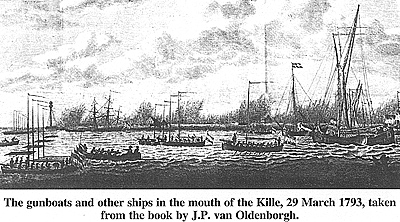Defense of the
Dutch Republic 1793
Dutch During the
Revolutionary Wars Part 11
Dutch Naval Forces at the River Front
by Geert van Uythoven, Netherlands
| |
Gunboats and other ships in the mouth of the Kille, 29 March 1793. Taken from the book by JP van Oldenborgh. As a further defence measure, and as already described in part 9 of the series, Naval Captain G. Oorthuis van de Capelle was ordered to bring all ships and boats over to the northern side of the Hollandsch Diep, to prevent these being used by the French. However, as would appear later, many inhabitants, for different reasons, did not want to give up their boats and hid these, only to be handed over to, or captured by the French. Order of battle of Van Kinsbergens' naval forces were as follows: [5]
Right Wing (Colonel and Naval Captain A.J. van Halm) Defending the Krammer from the Steenbergsche Vliet to the fortress-city Willemstad.
Under orders:
Centre (Rear-Admiral Pieter Melvill)
Defending the Hollandsch Diep from Hellevoctsluis and Willemstad to the Kille. The few boats already present here at the beginning of hostilities would be augmented to 32 in a few weeks.
Under orders:
Left Wing (Colonel and Naval Captain A.A. Bols) Defending the Island of Dordrecht and the Merwede, from the Kille to Hardinxveld.
Under orders:
On the Haringvliet and at Hellevoetsluis, the following ships were posted:
On 29 February, a French
reconnaissance party which crossed the Hollandsch Diep, in a boat, leaving the harbour of Noordschans and trying to land on the other side, was detected and all members taken prisoner. From their interrogation the Dutch learned that the French had 20,000 men around and near Willemstad, while the whole French army opposing the river front counted 40,000 men. Although these numbers were much higher then the real French strength, the weakness of the Dutch forces available, and the necessity to spread them along the whole front line, made the threat serious enough. The Dutch did everything to hamper any French endeavour to cross the riverfront.
The French could easily assemble ships and boats in the river Dintel and the Roode Vaart canal. Therefore, in the mouth of both waterways, a ship loaded with stones and sand was sunk. However, at the Roode Vaart the French were able to remove the sunken ship at low tide. The French threat became even more serious when the fortress-city Geertruidenberg was captured by them on 4 March,
[9] where they found thirty transport ships, the city in addition offering them a good and safe harbour for their future operations.
In addition, it was reported that the French had assembled fifteen boats on the Roode Vaart. On 6 March, the French had already twenty boats lying there. To counter the threat from Geertruidenberg, Vice-Admiral van Kinsbergen decided to strengthen his left wing by detaching four of the six gunboats on the Kille to Captain Bols.
Defense of the Dutch Republic 1793 Dutch in Revolutionary Wars Part 11
The Dutch During the Revolutionary Wars
|

 The Dutch navy defended the coastline and the Scheidt-estuary. As already described in a previous article, there were not enough ships available to defend also the Hollandsch Diep and the river front. So for this purpose all kinds of ships were hired and fitted out with cannon.
The Dutch navy defended the coastline and the Scheidt-estuary. As already described in a previous article, there were not enough ships available to defend also the Hollandsch Diep and the river front. So for this purpose all kinds of ships were hired and fitted out with cannon.